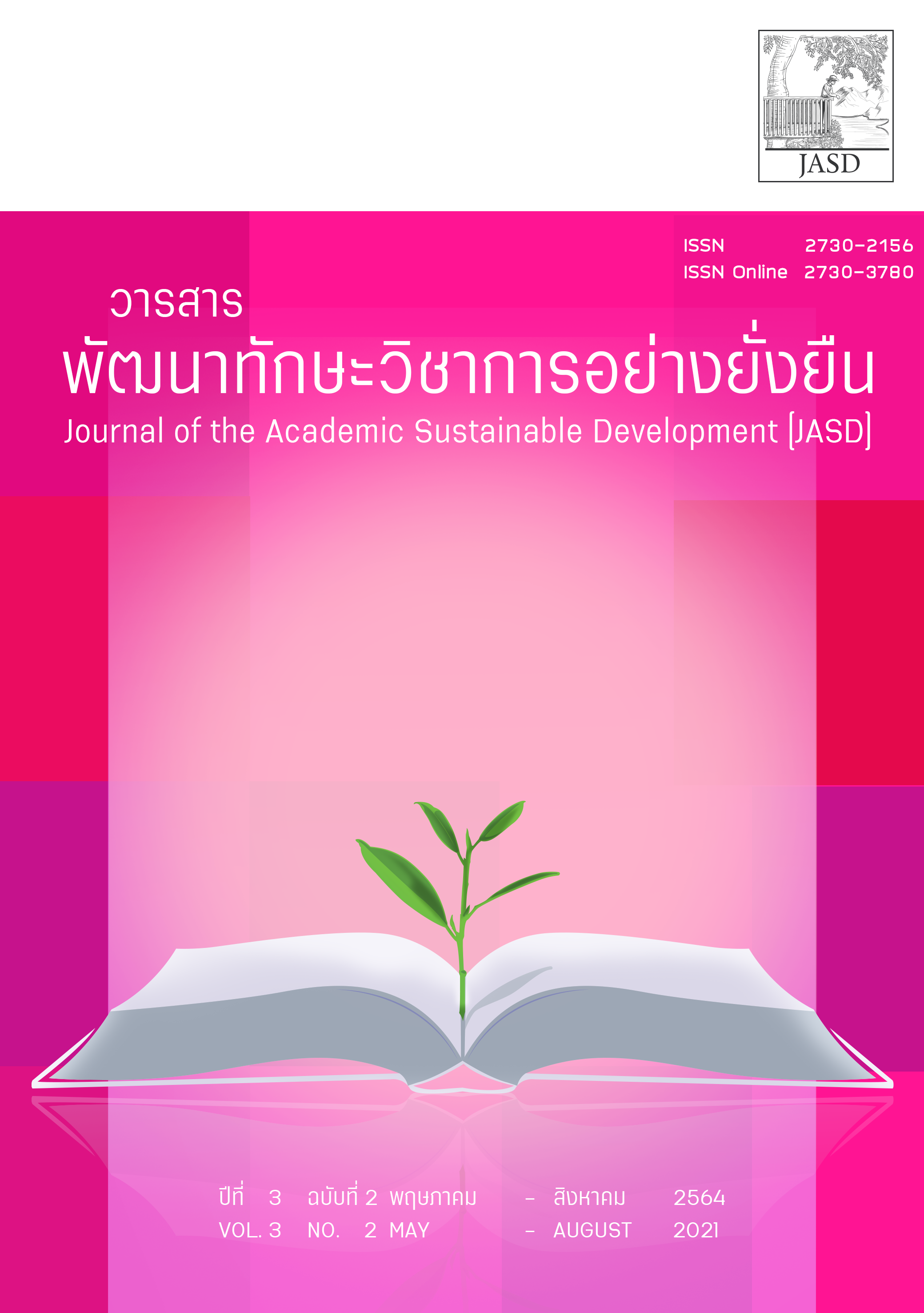The Development of Learning Achievement on One Variable Linear Equation using Cognitively Guided Instruction and STAD for Matthayomsuksa1 students, Muang Sawankhalok Municipal School, Sukhothai Province
Keywords:
lesson plans, CGI (Cognitively Guided Instruction), STAD (Student Teams Achievement Divisions)Abstract
The purposes of this study were to develop the mathematics lesson plan by using Cognitively Guided Instruction (CGI) and STAD on criteria 75/75 to compare the learning achievement to investigate the students’ satisfaction in teaching by using Cognitively Guided Instruction (CGI) and STAD. The sample of this study was 44 matthayomsuksa 1 students in academic year 2019 using random sampling. The instruments in this research were Cognitively Guided Instruction and STAD lesson plan, The mathematics learning achievement test, The students’ satisfaction questionnaire. Data were collected and analyzed by percentage, mean, standard deviation, E1/E2, and t-test. The results were as follows: 1) The mathematics lesson plan by using Cognitively Guided Instruction (CGI) and STAD lesson plans had the efficiency index of 77.54 / 81.40. 2) The students had learning achievement after learning higher than that before learning at the 0.05 level of significance. 3) Overall the students’ satisfaction in teaching by using Cognitively Guided Instruction (CGI) and STAD was at high level. ( =4.25, S.D.=0.54).
References
ฉันทพัฒน์ อุตตะมา. (2556). STAD: Student Teams Achievement Divisions. เข้าถึงจาก https://www.gotoknow.org/posts/553956.
ชัยวัฒน์ บำรุงจิตต์. (2559). การจัดการเรียนรู้แบบร่วมมือ กลุ่มสาระการเรียนรู้การงาน อาชีพ และเทคโนโลยี (งานช่างและงานประดิษฐ์1) ระดับชั้นมัธยมศึกษาตอนต้น. การประชุมวิชาการของมหาวิทยาลัยเกษตรศาสตร์ ครั้งที่ 54. สาขาศึกษาศาสตร์ มหาวิทยาลัยเกษตรศาสตร์.
ทิศนา แขมมณี. (2555). ศาสตร์การสอน : องค์ความรู้เพื่อการจัดกระบวนการเรียนรู้ที่มีประสิทธิภาพ. กรุงเทพฯ: จุฬาลงกรณ์มหาวิทยาลัย.
นิอร สุขสำราญ. (2559). เทคนิคการจัดการเรียนรู้แบบกลุ่มร่วมมือ. เข้าถึงจาก https://sites.google.com/site/khunkrunong/a1.
บุญชม ศรีสะอาด. (2556). วิธีการทางสถิติสำหรับการวิจัย เล่ม 1. พิมพ์ครั้งที่ 5. กรุงเทพฯ: สุวีริยาสาส์น.
ปานทอง กุลนาถศิริ. (2557). การจัดการศึกษาคณิตศาสตร์ในศตวรรษที่ 21. เข้าถึงจาก https://sites.google.com/site/snpinnrabawxin/home/nana-sara-kab-khnitsastr-1.
พิเชษฐ เทบำรุง. (2562). การพัฒนาแผนการจัดการเรียนรู้วิชาวิทยาศาสตร์และเทคโนโลยีสมัยใหม่ โดยใช้การเรียนรู้แบบ สืบเสาะหาความรู้ร่วมกับการเรียนรู้แบบอุปนัย เพื่อพัฒนาความสามารถในการคิดวิเคราะห์ และผลสัมฤทธิ์ทางการเรียน สำหรับนักศึกษาระดับปริญญาตรี. วารสารครุศาสตร์. ปีที่ 47(2).
โรงเรียนมัธยมศึกษาเทศบาลเมืองสวรรคโลก. (2562). รายงานผลการจัดการเรียนรู้ รายวิชา ค21102 คณิตศาสตร์ 2 ระดับชั้นมัธยมศึกษาปีที่ 1. สุโขทัย: โรงเรียนมัธยมศึกษาเทศบาลเมืองสวรรคโลก.
วิไลวรรณ ชูปั้น, เกษมสันต์ พานิชเจริญ และจันทร์พร พรหมมาศ. (2563). ผลการจัดการเรียนการสอนแนะให้รู้คิด (CGI) ร่วมกับเทคนิคเพื่อนคู่คิด (Think-Pair-Share) ที่มีต่อความสามารถในการให้เหตุผลและสมรรถนะด้านการสื่อสารทางคณิตศาสตร์ของนักเรียนชั้นมัธยมศึกษาปีที่ 2. e-Journal of Education Studies. ปีที่ 2(4).
สมพล คณานุเคราะห์. (2558). อาชีวศึกษา. เข้าถึงจาก http://km.tsc.ac.th/files/1506271010031630_15062812120310.
สุนิสา ทรัพย์สูงเนิน, ดุสิต ขาวเหลือง และสิราวรรณ จรัสรวีวัฒน์. (2563). ผลการจัดกิจกรรมการเรียนรู้โดยใช้รูปแบบการเรียนรู้แบบกลุ่มร่วมมือเทคนิค STAD สำหรับนักศึกษาระดับประกาศนียบัตรวิชาชีพชั้นสูง ปีที่ 1 สาขาการบัญชี. e-Journal of Education Studies. ปีที่ 2(2).
สุมิตรา ศรีธรรม. (2558). การพัฒนาชุดการสอนคณิตศาสตร์ที่เน้นวิธีเรียนแบบร่วมมือ โดยใช้เทคนิค STAD เรื่อง จำนวนจริง ชั้นมัธยมศึกษาปีที่ 2. วารสารเทคโนโลยีอุตสาหกรรม มหาวิทยาลัยราชภัฏอุบลราชธานี. ปีที่ 2(4).
Hiebert, J.C. (1997). Making sense: teaching and learning mathematics with understanding. Portsmouth, NH: Heine.




